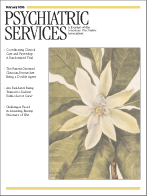Medicaid Eligibility and Access to Mental Health Services Among Adolescents in Substance Abuse Treatment
Abstract
OBJECTIVE: The co-occurrence of a mental disorder is common among adolescents who present for substance abuse treatment. This study was conducted to determine whether Medicaid eligibility was associated with greater use of mental health services. METHODS: The study used administrative data for 25,813 adolescents in Oregon. Propensity score analysis was used to assess the likelihood that the adolescents would use mental health services, with group differences and mental health need controlled for. RESULTS: Medicaid-eligible youths were nearly five times as likely to receive mental health services in the year they entered substance abuse treatment compared with non-Medicaid-eligible youths. In both groups, there was evidence of racial disparities as well as factors such as foster care that may facilitate access. CONCLUSIONS: The fact that Medicaid-eligible youths have greater access to mental health services should be considered in both state policies and research design. States considering ways to better serve adolescents with co-occurring disorders would do well to examine ways to promote Medicaid enrollment or expand eligibility.



